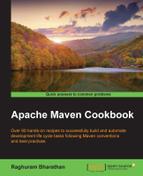Every Maven project has a pom file that defines what the project is all about and how it should be built. Pom is an acronym for project object model. Let us take a peek at this file.
Let's understand the pom file, by performing the following steps:
- Go to a Maven project that we created in previous chapters.
- Open the file named
pom.xml.
A pom file is an XML file that is based on a specific schema, as specified at the top of the file:
<project xmlns="http://maven.apache.org/POM/4.0.0"
xmlns:xsi="http://www.w3.org/2001/XMLSchema-instance"
xsi:schemaLocation="http://maven.apache.org/POM/4.0.0
http://maven.apache.org/xsd/maven-4.0.0.xsd">There is also a modelVersion element that defines the version of this schema:
<modelVersion>4.0.0</modelVersion>
These are the basic elements of a pom file.
The groupId element is a unique identifier of the organization to which the project belongs. For our sample project, it is org.packt.cookbook. It is a good practice to follow the reverse domain name notation to specify this:
<groupId>...</groupId>
The artifactId element is the name of the project. For our sample project, it is simple-project:
<artifactId>...</artifactId>
The version element is the specific instance of the project, corresponding to the source code at a particular instance of time. In our case, it is 1.0-SNAPSHOT, which is a default version during development:
<version>...</version>
We will explore the difference between the SNAPSHOT and concrete versions later in the book.
The combination of groupId, artifactId, and version uniquely identifies the project. In this sense, they are the coordinates of the project.
The packaging element indicates the artifact type of the project. This is typically a jar, war, zip, or in some cases, a pom:
<packaging>...</packaging>
The dependencies element section of the pom file defines all the dependent projects of this project. This would typically be third-party libraries required to build, test, and run the project:
<dependencies>...</dependencies>
The parent section is used to indicate a relationship, specifically a parent-child relationship. If the project is part of a multi-module project or inherits project information from another project, then the details are specified in this section:
<parent>...</parent>
Maven properties are
placeholders. Their values are accessible anywhere in the pom file by using ${key}, where key is the property name:
<properties>...</properties>
A project with modules is known as a multi-module or aggregator project. Modules are projects that this pom file lists and are executed as a group:
<modules>...</modules>
For more information on multi-module projects refer to Chapter 9, Multi-module Projects.
